 Technology peripherals
Technology peripherals
 AI
AI
 Learn multi-modal commands: Google image generation AI lets you easily follow along
Learn multi-modal commands: Google image generation AI lets you easily follow along
Learn multi-modal commands: Google image generation AI lets you easily follow along
Now there is a new image generation model designed by Google, which can draw the cat in Figure 1 in the style of Figure 2 and put a hat on it. This model uses instruction fine-tuning technology to accurately generate new images based on text instructions and multiple reference images. The effect is very good, comparable to a PS master personally helping you to create a picture.

We have recognized the importance of instruction fine-tuning when using large language models (LLM). With appropriate fine-tuning of instructions, LLM can perform a variety of tasks, such as composing poetry, writing code, writing scripts, assisting in scientific research, and even conducting investment management.
Now that large models have entered the multi-modal era, is instruction fine-tuning still effective? For example, can we fine-tune control of image generation through multi-modal instructions? Unlike language generation, image generation involves multimodality from the beginning. Can we effectively enable models to grasp the complexity of multimodality?
In order to solve this problem, Google DeepMind and Google Research proposed a multi-modal instruction method to achieve image generation. This method interweaves information from different modalities to express the conditions for image generation (example shown in the left panel of Figure 1).
Multimodal instructions can enhance language instructions. For example, users can specify the style of the reference image to generate a model to render the image. This intuitive interactive interface enables efficient setting of multimodal conditions for image generation tasks.
Based on this idea, the team created a multi-modal instruction image generation model: Instruct-Imagen.

Paper address: https://arxiv.org/abs/2401.01952

This model uses a Two-stage training method: first enhance the model's ability to handle multi-modal instructions, and then faithfully follow multi-modal user intentions.
In the first phase, the team adopted a pre-trained text-to-image model tasked with processing additional multi-modal inputs; later fine-tuning it to accurately respond to multi-modal status instructions. Specifically, the pre-trained model they took was a diffusion model and augmented with similar (image, text) context taken from a network-scale (image, text) corpus .
In the second phase, the team fine-tuned the model on a variety of image generation tasks, each of which was paired with corresponding multi-modal instructions—these instructions included the key to their respective tasks. elements. After the above steps, the resulting model Instruct-Imagen can very skillfully handle the fusion input of multiple modalities (such as sketches plus visual styles described with text instructions), so that it can generate images that accurately fit the context and are bright enough.
As shown in Figure 1, Instruct-Imagen performs exceptionally well, being able to understand complex multimodal instructions and generate images that faithfully follow human intent, even handling combinations of instructions that have never been seen before.

Human feedback shows that in many instances, Instruct-Imagen not only matches the performance of task-specific models on corresponding tasks, but even surpasses them. Not only that, Instruct-Imagen also shows strong generalization capabilities and can be used for unseen and more complex image generation tasks.
Multimodal instructions for generation
The pre-trained model used by the team is a diffusion model and users can set input conditions for it. For details, please see the original paper.
For multi-modal instructions, in order to ensure versatility and generalization capabilities, the team proposed a unified multi-modal instruction format, in which the role of language is to clearly state the goals of the task, multi-modal conditions It is provided as reference information.
This newly proposed command format contains two key components: (1) Payload text command, whose role is to describe the mission goal in detail and give reference information identification, such as [ref#?]. (2) Multimodal context, with paired (identity text, image). The model then uses a shared instruction understanding model to handle textual instructions and multimodal contexts—the specific modality of the context is not limited here.
Figure 2 shows how this format can represent various previous generation tasks through three examples, which shows that this format can be compatible with previous image generation tasks. More importantly, the language is flexible, so multimodal instructions can be extended for new tasks without any special design for modality and tasks.

Instruct-Imagen
Instruct-Imagen is based on multimodal instructions. Based on this, the team designed a model architecture based on a pre-trained text-to-image diffusion model, namely the cascaded diffusion model, so that it can fully adopt the input multi-modal instruction conditions.
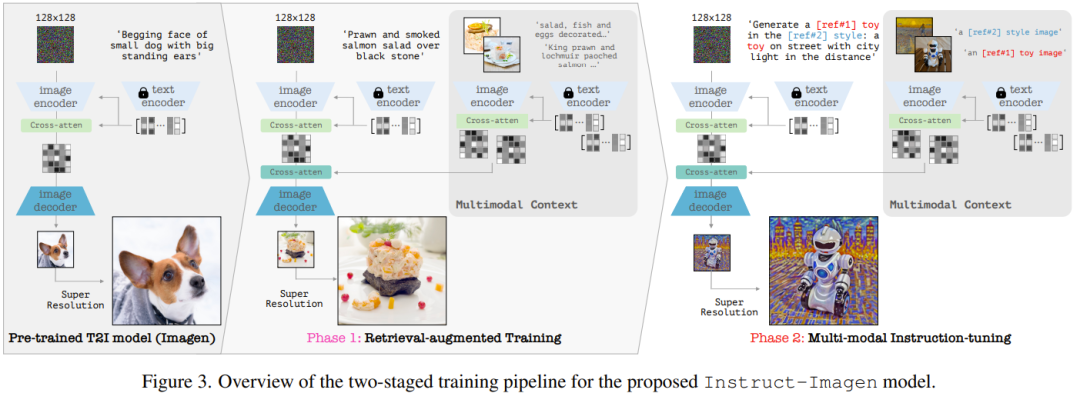
Specifically, they used a variant version of Imagen, see the paper "Photorealistic text-to-image diffusion models with deep language understanding", and based on their Pre-trained on internal data sources. Its complete model contains two sub-components: (1) text-to-image component, whose task is to generate 128×128 resolution images using only text prompts; (2) text conditional super-resolution model, which can convert 128-resolution images into Upgrade to 1024 resolution.
As for the encoding of multi-modal instructions, see Figure 3 (right), which shows the data flow of Instruct-Imagen encoding multi-modal instructions.
Training Instruct-Imagen with a two-stage method
The training process of Instruct-Imagen is divided into two stages.
The first stage is retrieval-enhanced text-to-image training, which uses the enhanced retrieved neighbor (image, text) pairs to continue training text-to-image generation.
The second stage is to fine-tune the output model of the first stage, which will use a mixture of diverse image generation tasks, each of which is paired with corresponding multi-modal instructions. Specifically, the team used 11 images across 5 task categories to generate the dataset, see Table 1.
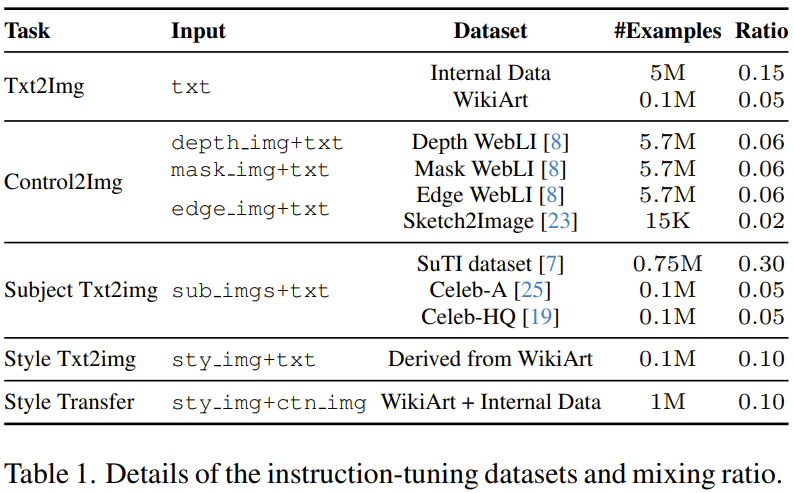
In both training stages, the model is optimized end-to-end.
Experimentation
The team conducted an experimental evaluation of the newly proposed method and model, and conducted an in-depth analysis of the design and failure modes of Instruct-Imagen.
Experimental Settings
The team evaluated the model in two settings, namely in-domain task evaluation and zero-shot task evaluation, with the latter setting being more efficient than The former setup is more challenging.
Main results
Figure 4 compares Instruct-Imagen with the baseline method and previous methods. The results show that it is comparable to the previous method in terms of in-field evaluation and zero-sample evaluation. Methods.
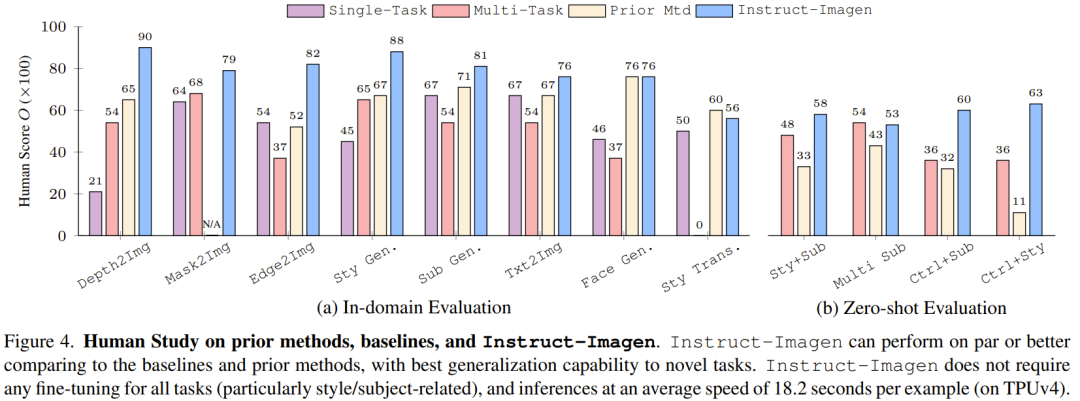
This shows that training with multimodal instructions can enhance model performance on tasks with limited training data (such as stylized generation), while maintaining performance on data-rich tasks (such as generating photo-like images). Without multi-modal instruction training, multi-task benchmarks tend to result in poor image quality and text alignment.
For example, in the in-context stylization example in Figure 5, the multi-task benchmark has difficulty distinguishing styles from objects, so the objects are reproduced in the generated results. For similar reasons, it also performs poorly on style transfer tasks. These observations highlight the value of instruction fine-tuning.
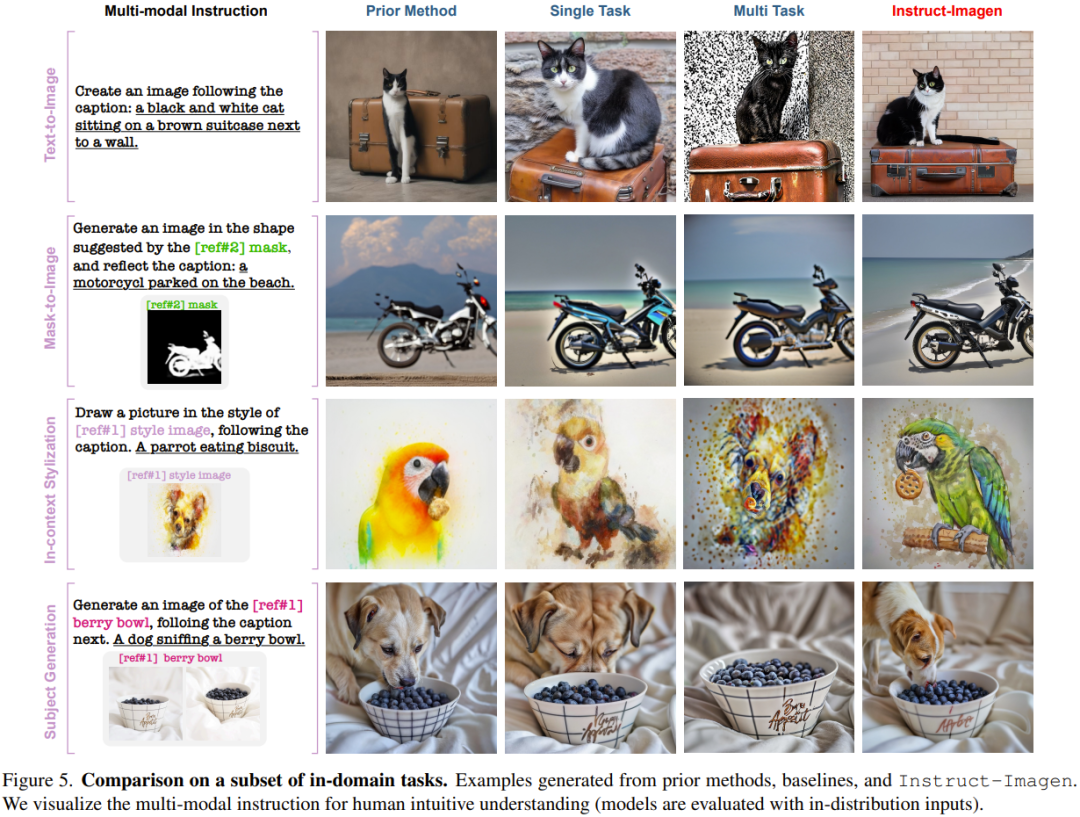
Unlike current methods or training that rely on specific tasks, Instruct-Imagen can be efficiently managed by leveraging instructions that combine the goals of different tasks and perform inference in context Combined task (no fine-tuning required, 18.2 seconds per example).
As shown in Figure 6, Instruct-Imagen always outperforms other models in terms of instruction following and output quality.

Not only that, when there are multiple references in a multi-modal context, the multi-task baseline model cannot correspond text instructions to references, resulting in some multi-modal The condition is ignored. These results further demonstrate the effectiveness of the newly proposed model.
Model Analysis and Ablation Study
The team analyzed the limitations and failure modes of the model.
For example, the team found that fine-tuned Instruct-Imagen can edit images. As shown in Table 2, by comparing the previous SDXL-inpainting, the Imagen fine-tuned on the MagicBrush dataset, and the fine-tuned Instruct-Imagen, it can be found that the fine-tuned Instruct-Imagen is significantly better than the one specifically designed for mask-based image editing. Design model.

However, the fine-tuned Instruct-Imagen produces artifacts in the edited images, especially the high-resolution output after the super-resolution step, as shown in Figure 7. The researchers say this is because the model has not previously learned to accurately copy pixels directly from context.
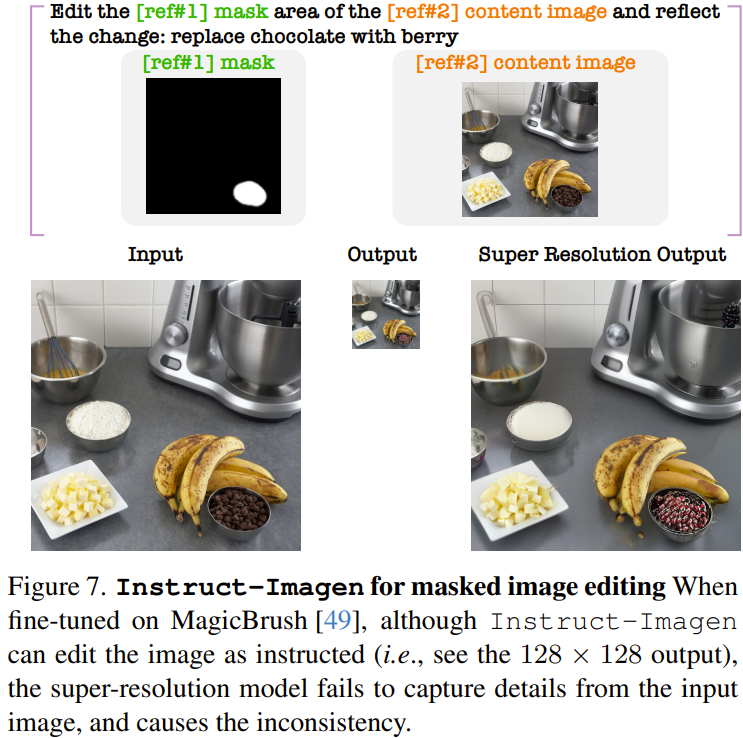
The team also found that retrieval-enhanced training can help improve generalization ability, and the results are shown in Table 3.

Regarding the failure mode of Instruct-Imagen, researchers found that when the multi-modal instructions are more complex (at least 3 multi-modal conditions), Instruct-Imagen is difficult to generate The result of following instructions. Figure 8 gives two examples.
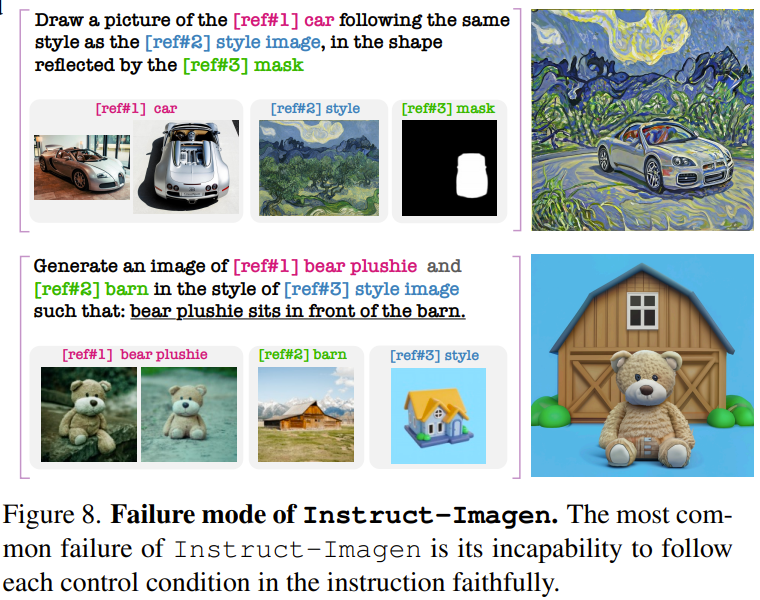
#The following shows some results on complex tasks that have not been seen during training.

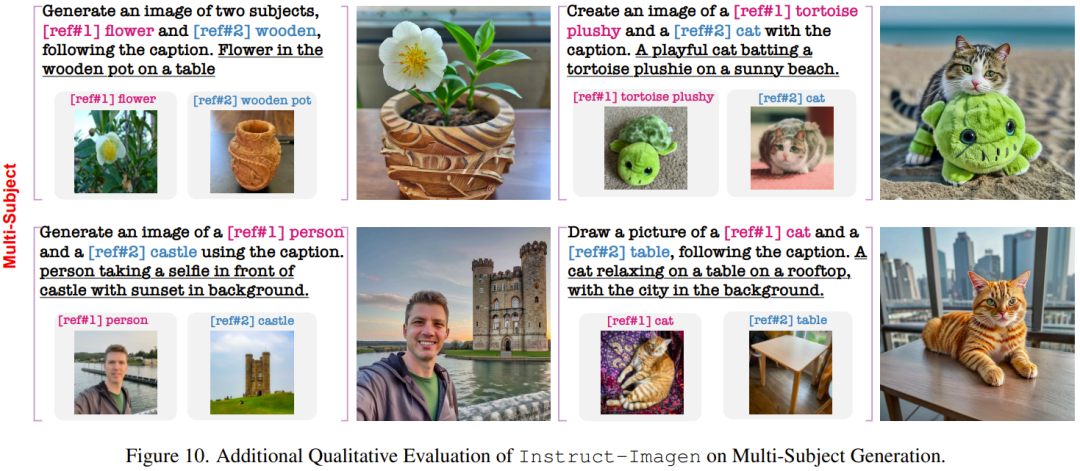

The team also conducted ablation studies to prove the importance of its design components.
However, due to security concerns, Google has not yet released the code and API of this research.
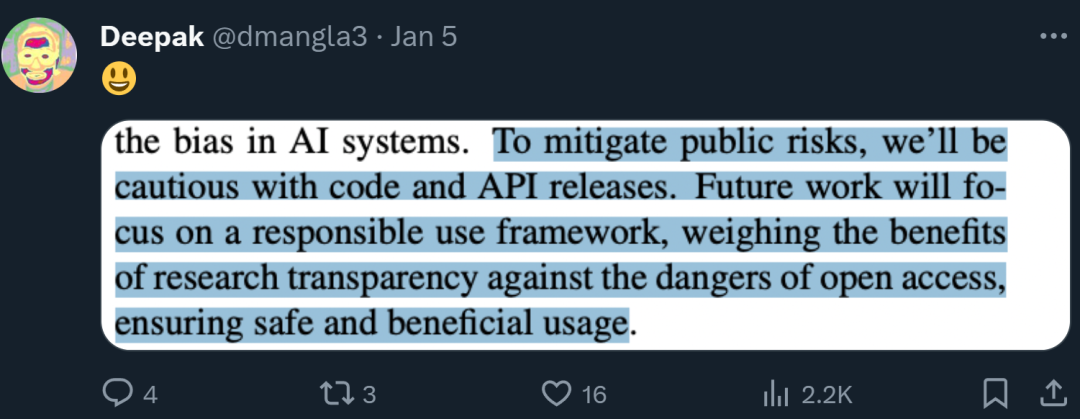
See original paper for more details.
The above is the detailed content of Learn multi-modal commands: Google image generation AI lets you easily follow along. For more information, please follow other related articles on the PHP Chinese website!

Hot AI Tools

Undresser.AI Undress
AI-powered app for creating realistic nude photos

AI Clothes Remover
Online AI tool for removing clothes from photos.

Undress AI Tool
Undress images for free

Clothoff.io
AI clothes remover

Video Face Swap
Swap faces in any video effortlessly with our completely free AI face swap tool!

Hot Article

Hot Tools

Notepad++7.3.1
Easy-to-use and free code editor

SublimeText3 Chinese version
Chinese version, very easy to use

Zend Studio 13.0.1
Powerful PHP integrated development environment

Dreamweaver CS6
Visual web development tools

SublimeText3 Mac version
God-level code editing software (SublimeText3)

Hot Topics
 1392
1392
 52
52
 DeepMind robot plays table tennis, and its forehand and backhand slip into the air, completely defeating human beginners
Aug 09, 2024 pm 04:01 PM
DeepMind robot plays table tennis, and its forehand and backhand slip into the air, completely defeating human beginners
Aug 09, 2024 pm 04:01 PM
But maybe he can’t defeat the old man in the park? The Paris Olympic Games are in full swing, and table tennis has attracted much attention. At the same time, robots have also made new breakthroughs in playing table tennis. Just now, DeepMind proposed the first learning robot agent that can reach the level of human amateur players in competitive table tennis. Paper address: https://arxiv.org/pdf/2408.03906 How good is the DeepMind robot at playing table tennis? Probably on par with human amateur players: both forehand and backhand: the opponent uses a variety of playing styles, and the robot can also withstand: receiving serves with different spins: However, the intensity of the game does not seem to be as intense as the old man in the park. For robots, table tennis
 The first mechanical claw! Yuanluobao appeared at the 2024 World Robot Conference and released the first chess robot that can enter the home
Aug 21, 2024 pm 07:33 PM
The first mechanical claw! Yuanluobao appeared at the 2024 World Robot Conference and released the first chess robot that can enter the home
Aug 21, 2024 pm 07:33 PM
On August 21, the 2024 World Robot Conference was grandly held in Beijing. SenseTime's home robot brand "Yuanluobot SenseRobot" has unveiled its entire family of products, and recently released the Yuanluobot AI chess-playing robot - Chess Professional Edition (hereinafter referred to as "Yuanluobot SenseRobot"), becoming the world's first A chess robot for the home. As the third chess-playing robot product of Yuanluobo, the new Guoxiang robot has undergone a large number of special technical upgrades and innovations in AI and engineering machinery. For the first time, it has realized the ability to pick up three-dimensional chess pieces through mechanical claws on a home robot, and perform human-machine Functions such as chess playing, everyone playing chess, notation review, etc.
 Claude has become lazy too! Netizen: Learn to give yourself a holiday
Sep 02, 2024 pm 01:56 PM
Claude has become lazy too! Netizen: Learn to give yourself a holiday
Sep 02, 2024 pm 01:56 PM
The start of school is about to begin, and it’s not just the students who are about to start the new semester who should take care of themselves, but also the large AI models. Some time ago, Reddit was filled with netizens complaining that Claude was getting lazy. "Its level has dropped a lot, it often pauses, and even the output becomes very short. In the first week of release, it could translate a full 4-page document at once, but now it can't even output half a page!" https:// www.reddit.com/r/ClaudeAI/comments/1by8rw8/something_just_feels_wrong_with_claude_in_the/ in a post titled "Totally disappointed with Claude", full of
 At the World Robot Conference, this domestic robot carrying 'the hope of future elderly care' was surrounded
Aug 22, 2024 pm 10:35 PM
At the World Robot Conference, this domestic robot carrying 'the hope of future elderly care' was surrounded
Aug 22, 2024 pm 10:35 PM
At the World Robot Conference being held in Beijing, the display of humanoid robots has become the absolute focus of the scene. At the Stardust Intelligent booth, the AI robot assistant S1 performed three major performances of dulcimer, martial arts, and calligraphy in one exhibition area, capable of both literary and martial arts. , attracted a large number of professional audiences and media. The elegant playing on the elastic strings allows the S1 to demonstrate fine operation and absolute control with speed, strength and precision. CCTV News conducted a special report on the imitation learning and intelligent control behind "Calligraphy". Company founder Lai Jie explained that behind the silky movements, the hardware side pursues the best force control and the most human-like body indicators (speed, load) etc.), but on the AI side, the real movement data of people is collected, allowing the robot to become stronger when it encounters a strong situation and learn to evolve quickly. And agile
 ACL 2024 Awards Announced: One of the Best Papers on Oracle Deciphering by HuaTech, GloVe Time Test Award
Aug 15, 2024 pm 04:37 PM
ACL 2024 Awards Announced: One of the Best Papers on Oracle Deciphering by HuaTech, GloVe Time Test Award
Aug 15, 2024 pm 04:37 PM
At this ACL conference, contributors have gained a lot. The six-day ACL2024 is being held in Bangkok, Thailand. ACL is the top international conference in the field of computational linguistics and natural language processing. It is organized by the International Association for Computational Linguistics and is held annually. ACL has always ranked first in academic influence in the field of NLP, and it is also a CCF-A recommended conference. This year's ACL conference is the 62nd and has received more than 400 cutting-edge works in the field of NLP. Yesterday afternoon, the conference announced the best paper and other awards. This time, there are 7 Best Paper Awards (two unpublished), 1 Best Theme Paper Award, and 35 Outstanding Paper Awards. The conference also awarded 3 Resource Paper Awards (ResourceAward) and Social Impact Award (
 Hongmeng Smart Travel S9 and full-scenario new product launch conference, a number of blockbuster new products were released together
Aug 08, 2024 am 07:02 AM
Hongmeng Smart Travel S9 and full-scenario new product launch conference, a number of blockbuster new products were released together
Aug 08, 2024 am 07:02 AM
This afternoon, Hongmeng Zhixing officially welcomed new brands and new cars. On August 6, Huawei held the Hongmeng Smart Xingxing S9 and Huawei full-scenario new product launch conference, bringing the panoramic smart flagship sedan Xiangjie S9, the new M7Pro and Huawei novaFlip, MatePad Pro 12.2 inches, the new MatePad Air, Huawei Bisheng With many new all-scenario smart products including the laser printer X1 series, FreeBuds6i, WATCHFIT3 and smart screen S5Pro, from smart travel, smart office to smart wear, Huawei continues to build a full-scenario smart ecosystem to bring consumers a smart experience of the Internet of Everything. Hongmeng Zhixing: In-depth empowerment to promote the upgrading of the smart car industry Huawei joins hands with Chinese automotive industry partners to provide
 Distributed Artificial Intelligence Conference DAI 2024 Call for Papers: Agent Day, Richard Sutton, the father of reinforcement learning, will attend! Yan Shuicheng, Sergey Levine and DeepMind scientists will give keynote speeches
Aug 22, 2024 pm 08:02 PM
Distributed Artificial Intelligence Conference DAI 2024 Call for Papers: Agent Day, Richard Sutton, the father of reinforcement learning, will attend! Yan Shuicheng, Sergey Levine and DeepMind scientists will give keynote speeches
Aug 22, 2024 pm 08:02 PM
Conference Introduction With the rapid development of science and technology, artificial intelligence has become an important force in promoting social progress. In this era, we are fortunate to witness and participate in the innovation and application of Distributed Artificial Intelligence (DAI). Distributed artificial intelligence is an important branch of the field of artificial intelligence, which has attracted more and more attention in recent years. Agents based on large language models (LLM) have suddenly emerged. By combining the powerful language understanding and generation capabilities of large models, they have shown great potential in natural language interaction, knowledge reasoning, task planning, etc. AIAgent is taking over the big language model and has become a hot topic in the current AI circle. Au
 Li Feifei's team proposed ReKep to give robots spatial intelligence and integrate GPT-4o
Sep 03, 2024 pm 05:18 PM
Li Feifei's team proposed ReKep to give robots spatial intelligence and integrate GPT-4o
Sep 03, 2024 pm 05:18 PM
Deep integration of vision and robot learning. When two robot hands work together smoothly to fold clothes, pour tea, and pack shoes, coupled with the 1X humanoid robot NEO that has been making headlines recently, you may have a feeling: we seem to be entering the age of robots. In fact, these silky movements are the product of advanced robotic technology + exquisite frame design + multi-modal large models. We know that useful robots often require complex and exquisite interactions with the environment, and the environment can be represented as constraints in the spatial and temporal domains. For example, if you want a robot to pour tea, the robot first needs to grasp the handle of the teapot and keep it upright without spilling the tea, then move it smoothly until the mouth of the pot is aligned with the mouth of the cup, and then tilt the teapot at a certain angle. . this



